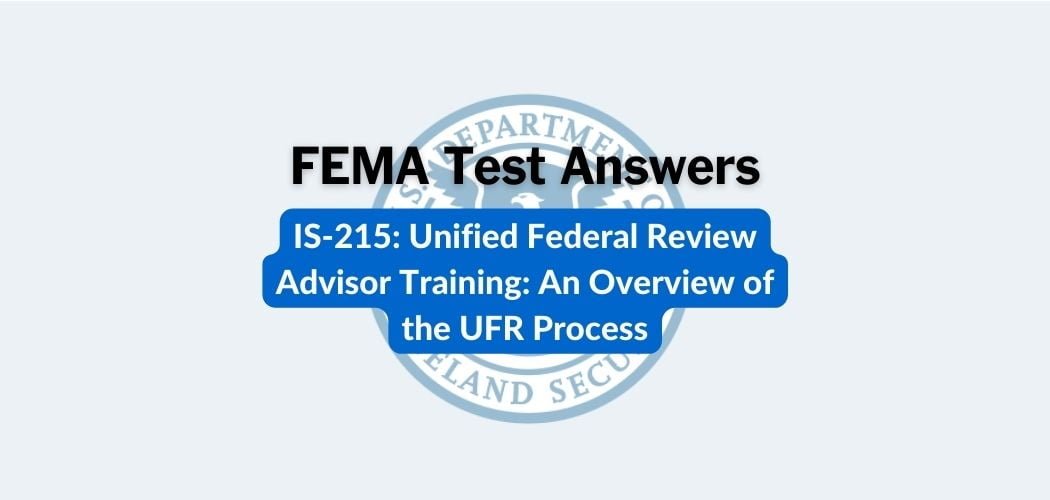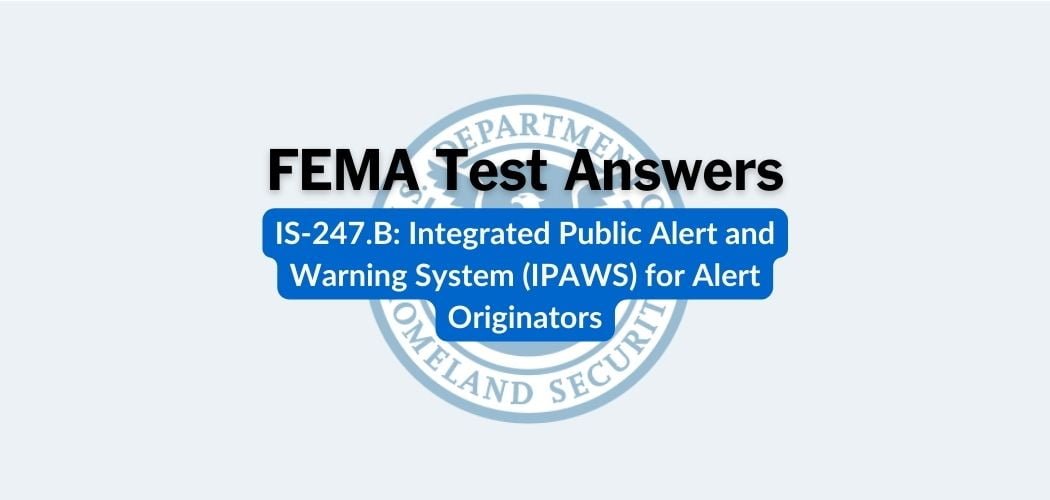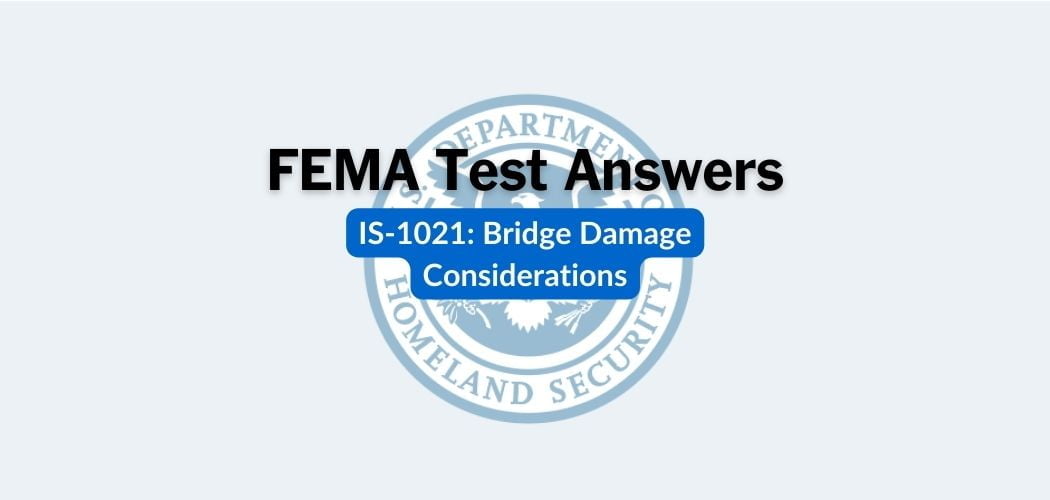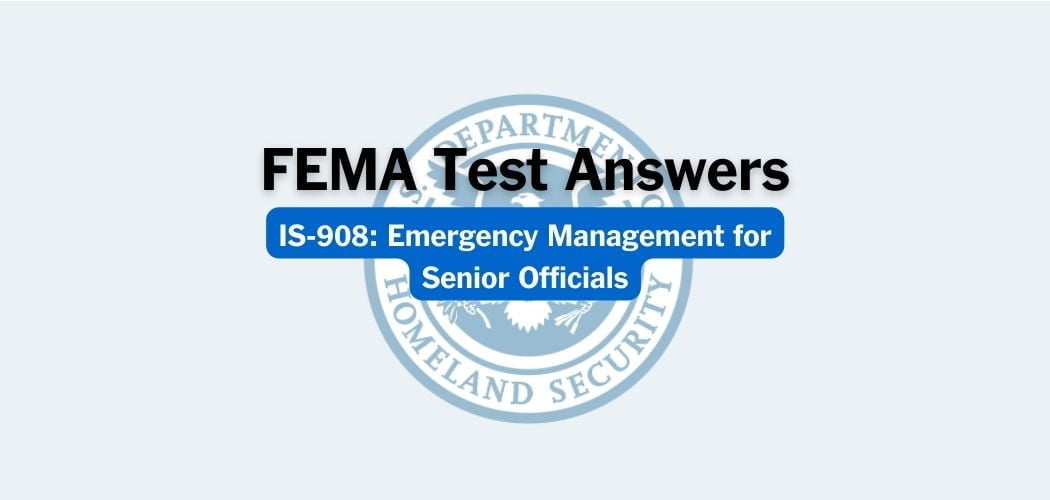Overview: The FEMA IS-253.A course was published on 6/13/2019 to provide an overview of FEMA’s environmental and historic preservation compliance responsibilities. This is an independent study alternative to the 4-day E/L253 course held at the Emergency Management Institute or in the regional offices.
FEMA IS-253.A is also designed to: provide the user with the basic background and practical knowledge needed to participate in FEMA’s environmental and historic preservation review process; help the user understand how the environmental or historic preservation review process applies to various job responsibilities within FEMA’s programs; and, provide the resources necessary for the user to accomplish environmental or historic preservation responsibilities.
FEMA IS-235.A test answers
Each time that this test is loaded, you will receive a unique set of questions and answers. The test questions are scrambled to protect the integrity of the exam.
Question 1. Ecologically sensitive and geologically vulnerable barrier islands along the East Coast, Gulf Coast, and Great Lakes are protected under the:
A. Clean Water Act.
B. Coastal Barrier Resources Act.✅
C. E.O.11988, Floodplain Management.
D. Wetlands Management Act.
Question 2. Floodplains are identified as zones in/on:
A. United States Geological Survey Maps.
B. Local land surveys and plats.
C. Any maps showing land within 1 mile of a body of water.
D. Flood Insurance Rate Maps.✅
Question 3. One of the qualifying criteria for inclusion on the National Register of Historic Places is that the property must be:
A. Reconstructed to its original specifications.
B. Significant within its historic context.✅
C. A building or structure.
D. More than 75 years old.
Question 4. Enacted by Congress and signed by the President, (blank) provide the legal basis and funding for programs and/or projects.
A. Executive Orders
B. Directives
C. Laws✅
D. Regulations
Question 5. Permits issued under the Clean Water Act are controlled by the U.S. Army Corps of Engineers and:
A. State water-control agencies.✅
B. Bureau of Land and Water Management.
C. FEMA.
D. Senior elected officials at the local level.
Question 6. Because all FEMA grants are considered Federal projects, they require compliance with environmental laws.
A. True
B. False✅
Question 7. A gas station is an example of a(n) _____ on the National Register.
A. Site
B. Location
C. Artifact
D. Building✅
Question 8. The Migratory Bird Treaty Act protects migratory bird species, their nests, and eggs.
A. True✅
B. False
Question 9. The primary historic preservation law for the nation is the:
A. National Environmental and Historic Protection Act.
B. National Historic Preservation Act.✅
C. National Protection of Significant Sites Act.
D. National Historic Registry Act.
Question 10. Swamps, bogs, and marshes all are classified in EO 11990 as:
A. Life-supporting water features.
B. Floodplains.
C. Wetlands.✅
D. Restricted building areas.
Question 11. _______ applies to FEMA actions that involve debris removal, staging, reduction (chipping, burning), and disposal activities, which are generally regulated at State and local levels.
A. Endangered Species Act.
B. Protection of Wetlands.
C. Resource Conservation and Recovery Act.✅
D. Invasive Species Act.
Question 12. The Gettysburg Battlefield is an example of a _______ on the National Register.
A. location
B. site ✅
C. property
D. district
Question 13. NEPA requires an outcome, not a process.
A. True
B. False✅
Question 14. FEMA actions most likely to require compliance and coordination with Natural Resources Conservation Service (NRCS) are those that involve:
A. New construction affecting prime or unique farmland.✅
B. Site selection for temporary housing units.
C. Socioeconomically disadvantaged populations.
D. National Historic Sites.
Question 15. The Vieux Carr’ (French Quarter) in New Orleans is classified as a:
A. location.
B. site.
C. area.
D. district.✅
Question 16. The National Historic Preservation Act requires Federal agencies, including FEMA, to consider the effects of agency actions on properties either listed on or eligible for listing on the National Register of Historic Places.
A. True✅
B. False
Question 17. FEMA’s primary statutory authority for disaster response and recovery activities is the:
A. National Flood Insurance Act.
B. Robert T. Stafford Disaster Relief and Emergency Assistance Act.✅
C. Post-Katrina Emergency Management Reform Act.
D. Disaster Mitigation Act of 2000.
Question 18. FEMA documents its decision-making for EOs 11988 (Floodplain Management) and 11990 (Protection of Wetlands) by completing an 8-step process. This process ensures that FEMA:
A. Limits its liability in projects restricted by the EOs.
B. Has an opportunity to complete an environmental impact statement on the project.
C. Considers how its actions affect floodplains and/or wetlands.✅
D. Provides all environmental groups time to request an environmental assessment on the project.
Question 19. Specific geographic areas (as defined by legislation) essential for the conservation and management of threatened and endangered species are classified as _____ habitat.
A. Protected.
B. Threatened.
C. Endangered.
D. Critical✅
Question 20. An example of a structure that might be included on the National Register is a/an:
A. Skyscraper.
B. Memorial plaque.
C. Bridge.✅
D. Orchard.
Question 21. Based on the SOW, there are four possible levels of review: The level of review is determined by the:
A. Type and size of the project.
B. Project’s eligibility for Individual Assistance, as opposed to Public Assistance
C. Number and extent of environmental impacts.✅
D. Degree to which all affected Federal agencies agree on the SOW.
Question 22. The Section 106 process requires the preservation of historic properties.
A. True✅
B. False
Question 23. The National Register of Historic Places is maintained by:
A. FEMA.
B. The Bureau of Land Management.
C. The Smithsonian Institution.
D. The National Park Service.✅
Question 24. The Comprehensive Environmental Response, Compensation, and Liability Act applies to:
A. All Federal recovery projects in urban areas.
B. Large, complex contaminated sites that may require extensive clean up and site remediation.✅
C. All projects for which the Environmental Protection Agency has management authority.
D. FEMA actions, such as the selection of temporary housing sites.
Question 25. An incomplete or inaccurate scope of work can:
A. Trigger an Environmental Assessment.
B. Be approved only if FEMA and the Environmental Protection Agency (EPA) agree.
C. Require state agencies to verify environmental impacts.
D. Delay project review and approval.✅
Question 26. The Endangered Species Act (ESA):
A. Requires States to review all development plans for their effect on endangered or threatened species.
B. Does not cover migratory birds and other wildlife.
C. Provides local and tribal governments with the authority they need to stop ineffective development.
D. Applies to everyone, not only to Federal agencies.✅
Question 27. EHP integrates the protection and enhancement of environmental, historic, and cultural resources into FEMA’s mission, programs, and activities by:
A. Ensuring FEMA actions comply with relevant Federal laws and Executive Orders.✅
B. Authorizing FEMA to serve as the lead Federal agency on all EHP actions.
C. Establishing a collaborative relationship among FEMA, the National Park Service, and the Environmental Protection Agency.
D. Requiring FEMA to conduct environmental assessments on all post-declaration projects.
Question 28. A primary goal of the National Environmental Policy Act is to:
A. Obligate Federal agencies to consider the potential impacts of their actions to the human environment before proceeding with any project.✅
B. Discourage construction projects in historic areas.
C. Require all projects to be voted on by referendum before approval.
D. Compel grantees to provide at least 4 alternatives for each proposed project.
Question 29. FEMA has entered into programmatic agreements that outline routine activities with minimal potential to affect historic properties. These agreements:
A. Eliminate State/tribal liability for work in or around a historic site.
B. Designate FEMA as the primary Federal agency overseeing work at the project site.
C. Allow certain projects to be excluded from Section 106 compliance.
D. Simplify and expedite the overall Section 106 process.✅
Question 30. Due to its unique disaster mission, FEMA is the only Federal agency granted statutory exclusions (STATEX authority) from compliance with NEPA.
A. True✅
B. False
Question 31. Providing assistance to help disaster survivors recover is one of the key components of a disaster operation. This help is provided through two main FEMA programs: Public Assistance and Individual Assistance.
A. True✅
B. False



